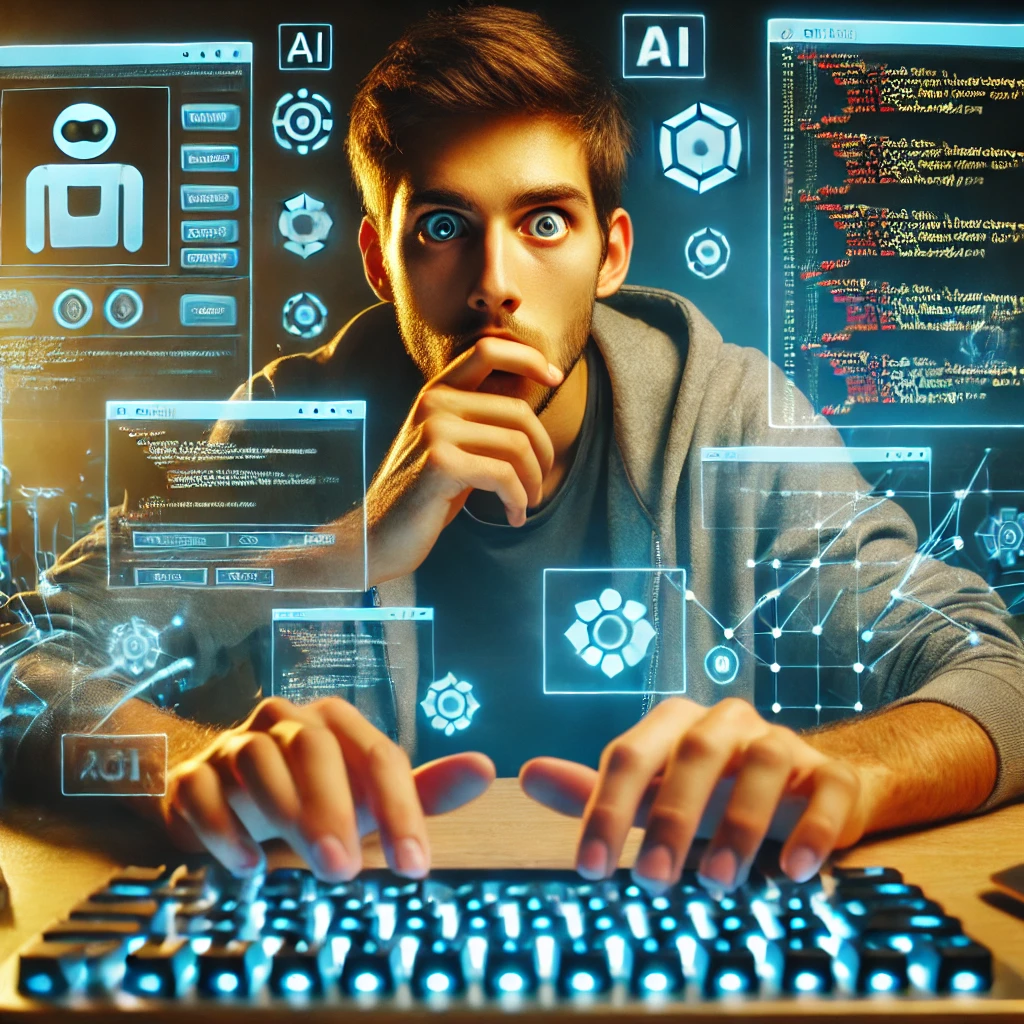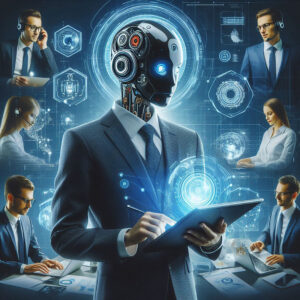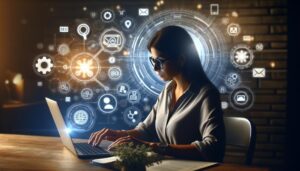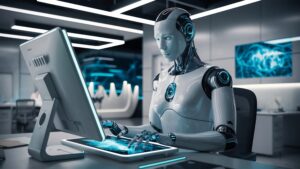How AI Made My Job Easier – But It Also Scared Me: A Developer’s Journey
The first time AI outperformed me at work, I panicked. Then, I realized how to use it to my advantage. As a seasoned software developer with over fifteen years of experience, I never expected a simple email organization task to trigger an existential crisis about the future of technology and my career. The familiar comfort of my development world suddenly felt precarious, teetering on the edge of a transformation I couldn’t fully comprehend. The quiet Sunday afternoon when I sat down to fix a minor email backup issue turned into a profound revelation about the future of my profession and the technology industry as a whole.
We strongly recommend that you check out our guide on how to take advantage of AI in today’s passive income economy.
Table of Contents
The Dawn of a New Era
As someone who witnessed the internet’s mass adoption firsthand, I can attest to the breathtaking speed of technological transformation. For those under 25, it’s impossible to fully grasp just how rapidly and profoundly that change occurred. I was fortunate to be at the forefront, one of the individuals who truly understood the magnitude of what was unfolding before us. In those early days, we watched as dial-up modems gave way to broadband, as static websites evolved into dynamic applications, and as the dream of a connected world became our everyday reality. The transformation wasn’t just technical – it fundamentally altered how we communicate, work, and live. Looking back, those changes seem inevitable, but living through them felt like watching the future unfold in real-time.
Understanding the Sigmoid Curve
New technologies typically follow a sigmoid curve pattern of adoption and development. Initially, there’s a gradual ascent as the technology emerges and major issues are resolved. Then comes an explosive growth phase where the technology’s utility becomes apparent, improvements accelerate, and competition flourishes. Finally, the curve plateaus as the technology reaches its practical limits. This pattern isn’t just a theoretical model – it’s a reflection of how human societies adopt and adapt to new tools and paradigms. The early adopters struggle through the difficulties, the mass market embraces the refined version, and eventually, the technology becomes so commonplace that we barely notice it anymore. The smartphone in your pocket followed this exact trajectory, from a curiosity to a necessity to an afterthought.
The Napster Moment
In 1999, Napster emerged as the harbinger of massive industrial disruption. It wasn’t merely about music sharing; it was the first major sign of how the internet would reshape or eliminate entire industries. From travel agencies to video rental stores, encyclopedias to shopping malls, the ripples of digital transformation touched everything. Napster represented the first thunder rumble of an approaching storm that would fundamentally alter our world. The music industry’s initial response – denial, then anger, then ineffective legal action – proved futile against the tide of technological change. Traditional business models crumbled, and new ones emerged from the debris. Now, twenty years later, the music industry has completely transformed, with streaming services dominating a landscape that physical media once ruled. The lesson wasn’t just about music; it was about the inevitability of digital transformation and the futility of resisting it.
The Current State of AI
I’m situated at a unique point in time and space, early 2023, witnessing what feels like another transformative moment. The comfortable digital world I’ve known appears poised for radical change. We’re riding a new sigmoid curve with artificial intelligence, and its trajectory remains uncertain. The signs are everywhere: AI systems composing music, writing code, creating art, and engaging in increasingly sophisticated conversations. The technology isn’t perfect – far from it – but its rapid improvement is undeniable. Each new iteration brings capabilities that seemed impossible just months before. The parallels to the early internet era are striking, but this time the potential for disruption feels even more profound.
The Email Dilemma
My journey with AI began with a seemingly mundane issue: email organization. Since 2004, when Gmail introduced its label system, I’ve stubbornly maintained my preference for folders. The distinction between labels and folders created an unexpected backup problem: over fifteen years, more than 100,000 messages had gone missing from my archives due to Gmail’s subtle handling of thread labels. This wasn’t just about lost emails – it was about the clash between old and new paradigms, between familiar workflows and evolving technologies. My resistance to change had created a technical debt that now demanded payment. The situation perfectly encapsulated the broader challenges of technological adaptation: sometimes our attachments to familiar systems blind us to better alternatives.
The AI Solution
Facing this massive organizational challenge, I turned to Google Apps Script, preparing to write code as I’ve done countless times before. But then I wondered: could AI help? Enter ChatGPT, which I’d previously dismissed as just another text prediction tool. My skepticism was rooted in years of experience with overhyped technologies that promised more than they could deliver. AI systems had always seemed impressive in demos but fell short in real-world applications. This time felt different. The technology wasn’t just mimicking human output – it was engaging in a genuine problem-solving process.
The Moment of Truth
Within seconds, ChatGPT generated working code that addressed my problem. Though slightly imperfect, its output matched what my first attempt would have been. More impressively, when I pointed out errors, it adapted and improved its solution. The AI even identified and worked around incorrect Google documentation – something that would have taken me hours to discover and resolve. This wasn’t just about code generation; it was about collaborative problem-solving. The AI understood context, recognized implications, and suggested alternatives. It wasn’t replacing my expertise – it was augmenting it, making me more effective and efficient. The experience challenged my assumptions about the limitations of AI technology.
The Existential Question
This experience triggered a deep-seated anxiety about the future of my profession. It wasn’t just about ChatGPT’s coding abilities; it was about what this technology represented. Like Napster in 1999, could this be the herald of another massive technological disruption? The implications extended far beyond my personal experience. If AI could match or exceed human performance in specialized technical tasks, what other professions might be transformed? The anxiety wasn’t about immediate obsolescence – it was about the long-term evolution of work itself.
Impact on Professional Identity
While my coding skills hadn’t evolved much since 2015, they had always been sufficient. Now, I found myself collaborating with an AI system that matched my capabilities. This wasn’t about being replaced immediately – the AI still struggled with complex logical problems – but it signaled a fundamental shift in how programming work might be done. The experience forced me to confront uncomfortable questions about professional growth and adaptation. In a world where AI can handle routine coding tasks, what skills become more valuable? How do we redefine expertise in an age of artificial intelligence?
The Broader Implications
The AI revolution extends beyond programming. When my barber mentioned using ChatGPT for writing formal emails, it reminded me of how Napster had spread beyond tech-savvy users. This widespread adoption suggests we’re witnessing the beginning of another transformative period in technology. The democratization of AI tools means that sophisticated capabilities are becoming accessible to everyone, not just technical specialists. This shift could fundamentally alter the relationship between humans and technology, creating new opportunities while disrupting established patterns of work and creativity.
The Future Landscape
If we’re at the start of the AI sigmoid curve, comparable to where Napster was in the internet’s evolution, we’re facing changes that could be as dramatic as those of the early 2000s. The comfortable world I’ve known might be transforming beyond recognition, and this time, I’m on the other side of the disruption. The challenge isn’t just technical – it’s psychological and social. How do we prepare for a future where AI is a collaborator rather than just a tool? What skills and mindsets will be crucial in this new landscape?
Adaptation and Growth
The realization that AI could match my coding abilities initially triggered fear, but it also sparked a crucial insight: the future belongs to those who learn to work with AI rather than against it. Just as the internet didn’t eliminate the need for human creativity and judgment, AI won’t replace human intelligence – it will amplify it. The key is to understand AI’s capabilities and limitations, to see it as a partner in problem-solving rather than a threat to our professional identity.
Learning to Collaborate
My experience with the email problem revealed that effective AI collaboration requires a new set of skills. It’s not enough to know how to code – we need to know how to communicate problems clearly, evaluate AI-generated solutions critically, and integrate AI capabilities into our existing workflows. This isn’t just about technical skills; it’s about developing a new kind of literacy that combines human insight with artificial intelligence.
The Path Forward
As I reflect on this experience, I see parallels with other technological transitions throughout history. The introduction of calculators didn’t eliminate mathematicians – it freed them to focus on more complex problems. Similarly, AI tools won’t eliminate programmers – they’ll enable us to tackle challenges that were previously beyond our reach. The key is to embrace this evolution while maintaining our professional judgment and creativity.
Embracing Change
The anxiety I felt when AI matched my coding abilities has transformed into curiosity about the possibilities ahead. Yes, the world of technology is changing rapidly, but change brings opportunity for those willing to adapt. The future of programming – and many other professions – will likely involve close collaboration between human and artificial intelligence, combining the best of both to achieve results neither could accomplish alone.
Conclusion
This personal journey with AI reveals a larger truth about technological change. Whether it’s email folders or entire industries, we all have systems and workflows we’re attached to. The approaching AI revolution promises to challenge these attachments, forcing us to adapt in ways we might not have chosen. The question isn’t whether change will come, but how we’ll respond when it does. My experience suggests that the path forward lies in embracing AI as a collaborator while maintaining our human perspective and judgment.
Final Thoughts
Looking back at this moment in the future, we’ll clearly see where we were on the AI adoption curve. For now, we navigate uncertainty with a mix of excitement and apprehension. While part of me hopes for stability, another part recognizes that the technological world never truly stands still. The key to thriving in this new era isn’t resistance but adaptation, not fear but curiosity, not competition with AI but collaboration with it.
A world with AI assistance in programming isn’t just coming – it’s already here. The challenge lies not in resisting this change but in learning to harness it effectively while maintaining our professional identity and expertise in an evolving landscape. The future belongs to those who can bridge the gap between human creativity and artificial intelligence, creating solutions that neither could achieve alone.

We strongly recommend that you check out our guide on how to take advantage of AI in today’s passive income economy.




